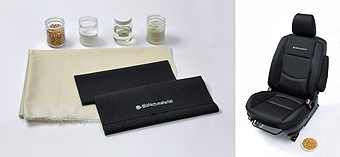
Automakers like Toyota, Honda, and General Motors as well as Nissan are focusing on the development of the so-called green vehicles. We already have the Prius. That looks weird but it saves a lot of fuel. The Insight, looks even weirder which might be the reason it has gone the way of dodos, but is also very frugal at the pump. Then we have promises from General Motors. These promises include the Chevy Volt (a sleek car that may not look as good when it comes to production), the Opel Flextreme and the plug-in Vue. Although the Yukon and Tahoe Hybrids are coming this fall, I still count them as promises.
While these automakers are so absorbed in the greeness of a vehicle, other automakers are striving to make green auto components. Although paint may not be considered as a component, I would just like to add here that Ford has succeeded in making the painting process a much greener task. The fumes given off during spray painting new cars are recycled by the automaker to be used as fuel. And then, there's this automaker from Japan known for the use of Wankel engines - Mazda.
The automaker which also makes the Mazda control arm recently announced that they have created the first fabric derived from plant fibers for automotive application. The biofabric, as the material is called, was made by the automaker in partnership with other Japanese companies which are Teijin Limited and Teijin Fibers Limited. According to them, the biofabric does not contain any traces of oil-based materials.
The fabric will be used as seat covers and door trims for the Premacy Hydrogen RE Hybrid which will be unveiled by the automaker at the upcoming Tokyo Motor Show this October. For those who are wondering what the Premacy looks like, well, in the United States and in Europe, the Premacy goes by the name of Mazda5.
"Mazda succeeded in developing this 100 percent plant-derived biofabric for use in vehicle interiors by leveraging the technical expertise we have amassed in the Hiroshima area," said the company's senior executive officer for R&D Seita Kanai. "We are convinced that our new technology, which enables the manufacture of this material without any oil-based resources, will become a cornerstone for future biotechnologies aimed at reducing the burden on the environment. Mazda, working together with our locally-based partners, will continue its research and development programs aimed at achieving a future car society that is eco-friendly," he added further.